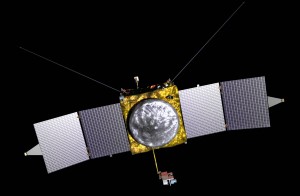
One goal of the preliminary design work that the MAVEN team carried out during Phase B was to identify and resolve the engineering issues that are going to crop up during development of any spacecraft mission. The more problems we could identify and fix early on, the fewer we would have to deal with later when they become much more expensive. I’d like to describe some of the different problems and how we dealt with them, in this and subsequent blog entries.
The first deals with spacecraft magnetic cleanliness. MAVEN carries a magnetometer that is designed to measure the magnetic field in the solar wind, in the near-Mars environment, and in the crust. The magnetic fields are small, and any magnetic field from the spacecraft itself will interfere with the measurements. Thus, we need to minimize the spacecraft magnetic fields that result from using permanent magnets in the various components (such as motors), and from electrical currents in the wiring.
We put the magnetometers at the ends of the solar panels, to get them as far away as possible from the main body of the spacecraft. Distance helps us, because the magnetic field from sources on the spacecraft body drops as the cube of the separation. This approach worked well on the Mars Global Surveyor (MGS) spacecraft.
Things are never easy, though.
Putting the magnetometers at the end of the solar arrays puts them in close proximity to the electrical currents that result from the generation of electricity. We have to be especially careful with potential sources on the solar arrays, particularly the wiring of the solar cells themselves. The solar arrays on MAVEN are wired differently from those on MGS, so that there is more variability in the current and, therefore, in the resulting magnetic field. And we are trying to measure smaller fields than MGS did. Together, these differences make controlling the spacecraft fields a much more challenging problem.
We looked at several different options to minimizing them, including adding a new boom just to hold the magnetometer. This option would have been effective but costly, with increased mass, cost, complexity, and risk. The option that we settled on is to extend the magnetometers past the end of the solar array as far as possible (on what we’ve termed a “diving board”), and then to wire the solar cells in circuits designed to be “self-cancelling”. This is done by placing the wires so that “current loops” created by the solar cell strings, which can create magnetic fields, are balanced by an equivalent loop on the same circuit that goes in the opposite direction; this cancels out most of the magnetic field. In addition, we’ll use “cancelling magnets” near the permanent magnets in the spacecraft subsystems; these will be oriented in the opposite direction so that, again, most of the magnetic field is cancelled out.
Our calculations show that we should be able to get rid of enough of the spacecraft magnetic field to be able to make our measurements very easily. Now that we have the concept, we need to finalize the design and then, just as importantly, we need to ensure that the spacecraft is built properly so that there are no stray fields. This is one example of how we need to get pretty deeply into the design in order to anticipate potential problems, understand them, and then find solutions that are both workable and cost-effective.

